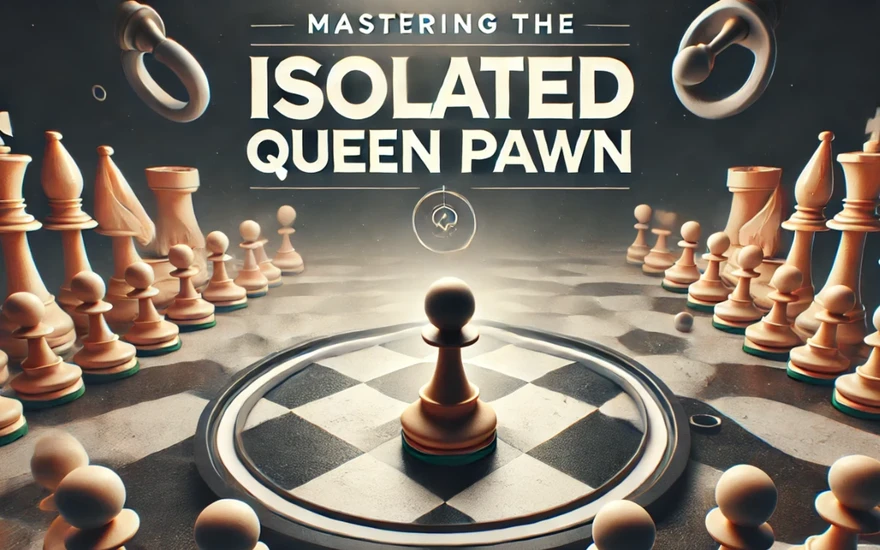
Mastering the Isolated Queen Pawn (IQP): An In-Depth Guide
The Isolated Queen Pawn (IQP) is one of the most dynamic and intriguing pawn structures in chess. In this blog, we explore its strengths, weaknesses, and strategic ideas for both sides, with practical examples to enhance your understanding of this critical concept.The Isolated Queen Pawn (IQP) is a unique and common pawn structure that arises frequently in games. Examples include positions from the Nimzo-Indian, Alapin, and Panov variations, among others. Perspectives on IQP structures vary: some players favor White’s initiative, others prefer Black’s structural advantage, and some find it drawish once White achieves the d5 break. In truth, all these perspectives have merits and demerits, depending on the position and play. Let’s delve deeper into the dynamics of the IQP. This blog's analysis is drawn from the book Winning Pawn Structures by Alexander Boburin, along with my own insights.
Understanding the IQP
Before exploring White and Black’s plans, it’s essential to understand the advantages and disadvantages of the IQP structure:
White’s Advantages:
- Open c-file and semi-open e-file for the rooks
- Easy development
- Attacking prospects
White’s Disadvantage:
- The isolated pawn on d4
Black’s Advantages:
- A clear target (the isolated pawn)
- Better pawn structure
- Favorable endgames
Black’s Disadvantages:
- Limited space
- The need to constantly watch for White’s attacking threats
White’s Ideas
1. d4-d5 Pawn Break Topalov-Gausel 1994: Despite Black’s solid position, White creates an attack with 13.d5! and followed by precise play.
2. Attack on f2/f7 Neverov-Maksimenko 1989: White plays 12.Ne5 Bc6 13.f4! targeting f7 and won a nice game. Ideas like Ne5-Rfe1-Nf7 are also something black has to care of.
3. Kingside Attack with Rook Lift Keene-Miles 1976: The rook lift 14.Re3 g6 15.Rg3 led white to establish a strong kingside attack with a sacrifice on g6.
4. Sacrifices on h6 Stean-Padevsky 1977: White's 17.Bg5 provokes h6, followed by 18.Bh6! A strong attack ensues, though White failed to convert it the win.
5. h4-h5 Pawn Storm Janjgava-Kalegin 1991: White’s creative 12.h4!? led to an interesting attack.
6. Queenside Play Kaidanov-Brunner 1993: White exchanged on f6 and played 16.Be4, exploiting weak squares on the c-file (c5 and c6) to grind positionally.
Black’s Ideas
Black’s strategy involves:
- Controlling the d5 square
- Reducing White’s kingside initiative
- Favorable exchanges to target the d4 pawn
Kortschnoj-Karpov 1981 Wch: Black plays 11...Nh5, a clean plan to facilitate exchanges and successfully grinds out a win.
Summary of Plans
- White: Use the initiative, avoid exchanges, and maintain piece activity. Every tempo is crucial maintain attacking chances.
- Black: Occupy the square in front of the IQP (d4 or d5) with a knight, exchange pieces favorably, and target the d4 pawn.
Conclusion
While IQP positions are often objectively equal, the side with superior understanding of the structure gains the upper hand. For further study, I highly recommend Winning Pawn Structures by Boburin. Share your thoughts and let me know topics you’d like me to cover in future blogs. Happy learning!
You may also like
 IM hari2209
IM hari2209My Lessons #1 - Overestimating the Opponent
There are always some psychological aspects involved in chess. One of the most common mistakes playe… IM hari2209
IM hari2209Interesting Opening Ideas from Tata Steel Masters 2025 (Round 1-7)
In this blog, we’ll dive into some interesting opening ideas that emerged during the first half of t… IM hari2209
IM hari2209